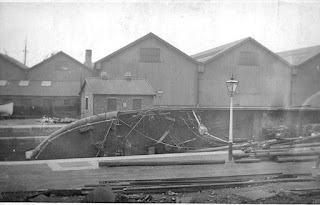I am hoping too that we will have good apple and plum crops later in the year as of course the bees have pollinated them.
We have put some jars in the porch outside our house, Joiner's Cottage in Saltmarshe along with our eggs and my booklet on the history of Saltmarshe - is this what they mean when people talk of a cottage industry?!
 |
But I have had time for a bit of historical research too. I wrote recently of the Leak family from Balkholme who emigrated to Utah. Well now I have found another local family who made a similar journey.
Charles and Mary England [nee Pears] lived at Skelton near Howden and had fourteen children. Their daughter Mary was the tenth child, born in August 1816.
An American descendant wrote that 'She grew to be a pretty woman with fine features, gray eyes, and black hair. She was a very refined, quiet, genteel lady -gifted in the art of needlework'.
Mary had two daughters, Elizabeth born 1837 at Skelton and Maria born 1840 at Portington before her marriage. In 1848 at Howden she married William Scott Cawkwell. He was a widower, then living at Sandhall and she was living at home in Skelton.
Soon after their marriage they moved to the Sheffield area where William worked as a carter. Mary's daughters Elizabeth, who had married William Ball and Maria, who had married Robert Boole and their families lived nearby.
Life was hard and the families were poor. In a description of the early life of Elizabeth's son Alfred we read he went to school for half a day and worked the other half in a cotton mill tying knots to set the loom for weaving cloth.
Then one day in 1863 Elizabeth heard the LDS.[ Mormon] missionaries preaching. She became interested and started to attend meetings. So did her mother Mary and both joined the LDS church.
Meanwhile the Mary and daughter Elizabeth's families moved to Rosedale where the men found work in the ironstone mines and the children worked loading coal into the furnaces.
But sadly Elizabeth was not well and the doctors said she had little time to live - it became her hearts’s desire to go to Salt Lake City, Utah.
Mary and Elixabeth sewed and sold quilts to raise money and in 1870 Elizabeth and her children set off. They left Liverpool for New York and travelled from New York to Salt Lake City by steam boat. arriving in Salt Lake City on August 5, 1870.
Elizabeth died February 24, 1871 and left her five children in the care of the church members. Meanwhile back in England Mary continued to work and save and the rest of the family left England on 11 June 1874 on the steamship Nevada, arriving in Salt Lake City on 2 July 1874.
Mary and William bought a small farm in Sandy, Utah, where they apparently enjoyed life.seeing their grandchildren marry, have homes and great grandchildren.
When I give talks people often say to me that people did not travel far in Victorian days. In fact it is surprising how many of them did.
 |
| I haven't any pictures of nineteenth century Skelton but here is the village celebrating Coronation Day in 1953. |



